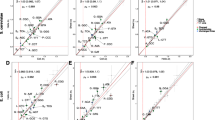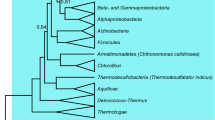Abstract
The genetic code is not random but instead is organized in such a way that single nucleotide substitutions are more likely to result in changes between similar amino acids. This fidelity, or error minimization, has been proposed to be an adaptation within the genetic code. Many models have been proposed to measure this adaptation within the genetic code. However, we find that none of these consider codon usage differences between species. Furthermore, use of different indices of amino acid physicochemical characteristics leads to different estimations of this adaptation within the code. In this study, we try to establish a more accurate model to address this problem. In our model, a weighting scheme is established for mistranslation biases of the three different codon positions, transition/transversion biases, and codon usage. Different indices of amino acids’ physicochemical characteristics are also considered. In contrast to pervious work, our results show that the natural genetic code is not fully optimized for error minimization. The genetic code, therefore, is not the most optimized one for error minimization, but one that balances between flexibility and fidelity for different species.

Similar content being viewed by others
References
C Alff-Steinberger (1969) ArticleTitleThe genetic code and error transmission. Proc Natl Acad Sci USA 64 203–207
FHC Crick (1968) ArticleTitleThe origin of genetic code. J Mol Biol 38 367–293 Occurrence Handle1:CAS:528:DyaF1MXksVSiug%3D%3D Occurrence Handle4887876
M Di Giulio (1989) ArticleTitleThe extension reached by minimization of the polarity distances during the evolution of the genetic code. J Mol Evol 29 288–293 Occurrence Handle1:CAS:528:DyaL1MXmt1Ogurc%3D Occurrence Handle2514270
M Di Giulio (2000) ArticleTitleGenetic code origin and the strength of natural selection. J Theoret Biol 205 659–661 Occurrence Handle10.1006/jtbi.2000.2115 Occurrence Handle1:CAS:528:DC%2BD3cXlsVSrsrw%3D
DM Engelman TA Steitz A Goldman (1986) ArticleTitleIdentifying nonpolar transbilayer helices in amino acid sequences of membrane proteins. Annu Rev Biophys Biophys Chem 15 321–353
SJ Freeland LD Hurst (1998) ArticleTitleThe genetic code is one in a million. J Mol Evol 47 238–248 Occurrence Handle1:CAS:528:DyaK1cXmt1ansrs%3D Occurrence Handle9732450
SJ Freeland RD Knight LF Landweber (2000a) ArticleTitleMeasuring the adaptation within the genetic code. Trends Biochem Sci 25 44–45 Occurrence Handle1:CAS:528:DC%2BD3cXhsFejtr4%3D
SJ Freeland et al. (2000b) ArticleTitleEarly fixation of an optimal genetic code. Mol Biol Evol 17 511–518 Occurrence Handle1:CAS:528:DC%2BD3cXisVSgt70%3D
D Haig LD Hurst (1991) ArticleTitleA quantitative measure of error minimization in the genetic code. J Mol Evol 33 412–417 Occurrence Handle1:CAS:528:DyaK3MXmsleqtrs%3D Occurrence Handle1960738
RD Knight SJ Freeland LF Landweber (1999) ArticleTitleSelection, history and chemistry: The three faces of the genetic code. Trends Biochem Sci 24 241–247 Occurrence Handle10.1016/S0968-0004(99)01392-4 Occurrence Handle1:CAS:528:DyaK1MXks1ansLg%3D Occurrence Handle10366854
J Kyte RF Doolittle (1982) ArticleTitleA simple method for displaying the hydropathic character of a protein. J Mol Biol 157 105–132 Occurrence Handle1:CAS:528:DyaL38Xks1yjtro%3D Occurrence Handle7108955
AL Lehninger (1982) Principles of biochemistry. Worth New York
S Miller J Janin AM Lesk C Chothia (1987) ArticleTitleInterior and surface of monomeric proteins. J Mol Biol 196 641–656 Occurrence Handle1:CAS:528:DyaL1cXitlWh Occurrence Handle3681970
Y Nakamura T Gojobori T Ikemura (1999) ArticleTitleCodon usage tabulated from the international DNA sequence databases; Its status 1999. Nucleic Acids Res 27 292–292 Occurrence Handle1:CAS:528:DyaK1MXpsVKgtw%3D%3D Occurrence Handle9847205
Y Nozaki C Tanford (1971) ArticleTitleThe solubility of amino acids and two glycine peptides in aqueous ethanol and dioxane solutions. Establishments of a hydrophobicity scale. J Mol Chem 246 2111
CR Woese (1965a) ArticleTitleOrder in the genetic code. Proc Natl Acad Sci USA 54 71–75 Occurrence Handle1:CAS:528:DyaF2MXks1Cmsrk%3D
CR Woese (1965b) ArticleTitleOn the evolution of the genetic code. Proc Natl Acad Sci USA 54 1546–1552 Occurrence Handle1:CAS:528:DyaF28Xltlagsg%3D%3D
CR Woese DH Dugre SA Dugre M Kondo WC Saxinger (1966) ArticleTitleOn the fundamental nature and evolution of the genetic code. Cold Spring Habor Symp Quant Biol 31 723–736 Occurrence Handle1:CAS:528:DyaF2sXks1Srtrw%3D
Acknowledgements
The authors sincerely appreciate Zhen Yao and Zhi-Hong Zhang for instructive advice on programming. In addition, we thank Prof. Yang Zhong, Dr. Li-Ying Cui, and Dr. Thomas Merritt for helpful discussions. We are also very gratitude to anonymous referees for very informative comments on the manuscript. C.-T. Zhu (Zhu Lei) is supported by a Chun-Tsung fellowship at Fudan University endowed by Tsung-Dao Lee, 1957 Nobel Prize laureate in physics.
Author information
Authors and Affiliations
Corresponding author
Appendices
Appendix A
Let us, for convenience in describing the sums performed, refer to four bases by number; U = 1, C = 2, A = 3, and G = 4. Let the characteristic Q be specified by a corresponding base triple (L, M, N) of the amino acid. T is the quantification of combined weighting of mistranslation, transition, and transversion. U (L, M, N) is the codon usage of the triple (L, M, N). UWMS measurement can be defined as follows (stop codons are excluded).

Codon usage of a certain species is calculated from all the coding sequences of that species reported to GenBank. The codon usage of each codon is measured by the relative frequency of the count of that codon versus the count of all codons. Codon usage of a certain species is consequently a vector of 61 variables.
Codon usage data were obtained from the Codon Usage Database (ftp://www.kazusa.or.jp/ ) in August 1999 (Nakamura 1999).
Appendix B
A Delphi 3.0 program was written for calculation. The random codes have the same degenerate pattern as the natural code, only the positions of amino acids were changed. Four million codes are generated using a cycle function; in one cycle, 4000 codes are generated and calculated. In every cycle, the 4000 codes are all different. Although a code may be generated and calculated more than once in 1000 cycles, in such a big population, sampling with or without replacement has the same meaning.
The program and source code are available on request to the authors.
Rights and permissions
About this article
Cite this article
Zhu, CT., Zeng, XB. & Huang, WD. Codon Usage Decreases the Error Minimization Within the Genetic Code . J Mol Evol 57, 533–537 (2003). https://doi.org/10.1007/s00239-003-2505-7
Received:
Accepted:
Issue Date:
DOI: https://doi.org/10.1007/s00239-003-2505-7




